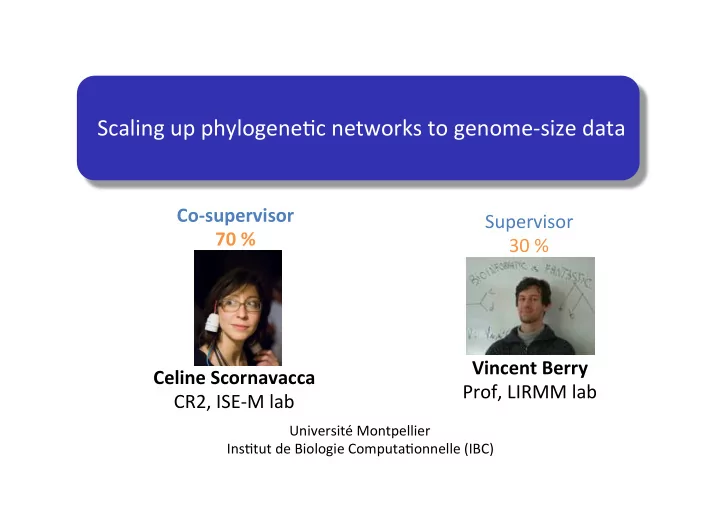

Scaling ¡up ¡phylogene/c ¡networks ¡to ¡genome-‑size ¡data ¡ Co-‑supervisor ¡ Supervisor ¡ 70 ¡% ¡ 30 ¡% ¡ Vincent ¡Berry ¡ Celine ¡Scornavacca ¡ Prof, ¡LIRMM ¡lab ¡ CR2, ¡ISE-‑M ¡lab ¡ ¡ Université ¡Montpellier ¡ Ins/tut ¡de ¡Biologie ¡Computa/onnelle ¡(IBC) ¡ ¡
Phylogene/c ¡trees ¡ Rooted ¡phylogene/c ¡trees ¡are ¡used ¡to ¡depict ¡the ¡evolu/onary ¡history ¡of ¡a ¡ set ¡of ¡taxa , ¡ whose ¡internal ¡nodes ¡represent ¡specia/on ¡events. ¡ ¡ ¡ ¡ ¡ ¡ ¡ ¡ ¡ ¡ ¡ ¡ ¡ ¡ ¡ ¡ ¡ ¡ out-‑branching ¡trees ¡with ¡no ¡indegree-‑1 ¡outdegreee-‑1 ¡nodes ¡and ¡whose ¡leaves ¡are ¡each ¡ associated ¡to ¡a ¡species ¡or ¡gene ¡(taxa) ¡ ¡
Phylogene/c ¡trees ¡ Rooted ¡phylogene/c ¡trees ¡are ¡used ¡to ¡depict ¡the ¡evolu/onary ¡history ¡of ¡a ¡ set ¡of ¡taxa , ¡ whose ¡internal ¡nodes ¡represent ¡specia/on ¡events. ¡ ¡ But ¡… ¡Darwin ¡described ¡evolu/on ¡as ¡‘descent ¡with ¡modifica/on’ ¡ ¡ (does ¡not ¡necessarily ¡imply ¡a ¡tree ¡representa;on…) ¡ The ¡Origin ¡of ¡ Species ¡(1859) ¡ The ¡implicit ¡assump/on ¡of ¡using ¡trees ¡is ¡that, ¡at ¡a ¡macroevolu/onary ¡scale, ¡ each ¡(current ¡or ¡ex/nct) ¡species ¡or ¡gene ¡ only ¡descends ¡from ¡one ¡ancestor ¡ ¡
Re/culate ¡evolu/on ¡ However, ¡at ¡a ¡larger ¡scale, ¡genomes ¡some/mes ¡inherit ¡from ¡mul/ple ¡ ancestors, ¡because ¡of ¡re/culate ¡events, ¡e.g: ¡ ¡ ¡ ¡ 1) Hybrid ¡specia;on ¡ 2) Lateral ¡gene ¡transfer ¡ 3) Recombina/on ¡
Re/culate ¡evolu/on ¡ However, ¡at ¡a ¡larger ¡scale, ¡genomes ¡some/mes ¡inherit ¡from ¡mul/ple ¡ ancestors, ¡because ¡of ¡re/culate ¡events, ¡e.g: ¡ ¡ ¡ ¡ 1) Hybrid ¡specia;on ¡ 2) Lateral ¡gene ¡transfer ¡ 3) Recombina/on ¡
Re/culate ¡evolu/on ¡ However, ¡at ¡a ¡larger ¡scale, ¡genomes ¡some/mes ¡inherit ¡from ¡ mul/ple ¡ancestors, ¡because ¡of ¡re/culate ¡events, ¡e.g: ¡ ¡ ¡ ¡ 1) Hybrid ¡specia/on ¡ 2) Lateral ¡gene ¡transfer ¡ 3) Recombina/on ¡
Re/culate ¡evolu/on ¡ However, ¡at ¡a ¡larger ¡scale, ¡genomes ¡some/mes ¡inherit ¡from ¡mul/ple ¡ ancestors, ¡because ¡of ¡re/culate ¡events, ¡e.g: ¡ ¡ ¡ ¡ 1) Hybrid ¡specia/on ¡ Puta/ve ¡phylogeny ¡of ¡HIV/SIV ¡ infec/ng ¡primates ¡ ¡ 2) Lateral ¡gene ¡transfer ¡ (Bailes ¡et ¡al. ¡Science ¡2003) ¡ 3) Recombina;on ¡
Phylogene/c ¡networks ¡ In ¡the ¡presence ¡of ¡re/culate ¡events, ¡ phylogenies ¡are ¡networks ¡(DAGs), ¡not ¡ trees ¡ Dooli`le ¡ The ¡study ¡of ¡phylogene/c ¡networks ¡is ¡ Science ¡ ¡ a ¡recent ¡interdisciplinary ¡field: ¡maths, ¡ 1999 ¡ CS, ¡biology… ¡ 2013 ¡ 2008 ¡ 2010 ¡ 2011 ¡
Phylogene/c ¡network ¡inference ¡ N The ¡phylogene/c ¡network ¡ community ¡considers ¡that ¡the ¡ ra/o ¡data/re/cula/on ¡events ¡is ¡ a b c d e f ‘large ¡enough’ ¡to ¡allow ¡the ¡ inference ¡of ¡the ¡network ¡itself. ¡ ? ¡
Phylogene/c ¡network ¡inference ¡ N The ¡phylogene/c ¡network ¡ community ¡considers ¡that ¡the ¡ ra/o ¡data/re/cula/on ¡events ¡is ¡ a b c d e f ‘large ¡enough’ ¡to ¡allow ¡the ¡ inference ¡of ¡the ¡network ¡itself. ¡ ? ¡ ¡However, ¡most ¡biological ¡literature ¡s/ll ¡uses ¡trees ¡even ¡when ¡a ¡network ¡ would ¡be ¡more ¡suitable ¡because ¡network ¡methods ¡developed ¡so ¡far ¡ ¡ • do ¡not ¡yet ¡take ¡the ¡full ¡biological ¡complexity ¡into ¡account , ¡and ¡ ¡ • do ¡not ¡scale ¡up ¡to ¡genomic ¡data ¡ (based ¡on ¡op/miza/on ¡problems ¡that ¡ are ¡computa/onally ¡hard, ¡oben ¡even ¡to ¡approximate). ¡
Training ¡period ¡at ¡ISEM/LIRMM ¡ Phylogene/c ¡networks ¡have ¡been ¡intensively ¡studied ¡from ¡a ¡mathema/cal ¡and ¡ • computa/onal ¡perspec/ve ¡in ¡the ¡last ¡years; ¡the ¡bibliographic ¡part ¡of ¡the ¡stage ¡will ¡ thus ¡focus ¡on ¡the ¡literature ¡on ¡phylogene/c ¡networks ¡published ¡since ¡the ¡ appearance ¡of ¡[1], ¡and ¡will ¡lead ¡to ¡the ¡produc/on ¡of ¡a ¡report ¡upda/ng ¡the ¡survey ¡ provided ¡in ¡[Scornavacca ¡et ¡al ¡2012] ¡ ¡A ¡possible ¡approach ¡is ¡to ¡iden/fy ¡subsets ¡of ¡varie/es ¡that ¡encompass ¡maximum ¡ • diversity ¡and ¡for ¡which ¡largest ¡regions ¡of ¡consecu/ve ¡loci ¡in ¡the ¡genome ¡have ¡a ¡ tree-‑like ¡evolu/onary ¡history. ¡These ¡ground ¡trees ¡will ¡then ¡serve ¡to ¡compute ¡a ¡ phylogene/c ¡network ¡[1] ¡represen/ng ¡hybridiza/on ¡events ¡through ¡which ¡these ¡ trees ¡were ¡obtained ¡from ¡the ¡ini/al ¡founders. ¡ ¡
PhD ¡Thesis ¡plan ¡ 1. Speed ¡up ¡the ¡phylogene;c ¡networks ¡reconstruc;on : ¡ Design ¡ models ¡taking ¡more ¡into ¡account ¡the ¡biological ¡complexity ¡: ¡ • duplica/on, ¡loss, ¡transfers ¡in ¡gene ¡family ¡evolu/on ¡; ¡syntenies ¡in ¡ genome ¡architecture ¡; ¡regulatory ¡networks ¡; ¡… ¡ More ¡factors ¡-‑> ¡ reduced ¡combinatorics ¡ • Leverage ¡these ¡new ¡features ¡to ¡design ¡ algorithms ¡with ¡reasonable ¡ • running ¡/mes. ¡ 2. Obtain ¡a ¡realis;c ¡picture ¡of ¡ancestral ¡genomes' ¡ composi/on ¡(which ¡genes, ¡ on ¡which ¡chromosomes,...) ¡ ¡for ¡ancestral ¡species ¡involved ¡in ¡re;culate ¡ evolu;on: ¡ Extend ¡available ¡methods ¡designed ¡for ¡trees ¡to ¡networks, ¡while ¡ • limi/ng ¡the ¡combinatorial ¡explosion ¡ ¡ 3. Apply ¡methods ¡ on ¡plant ¡real ¡data ¡(Oryza, ¡Banana, ¡…) ¡to ¡explain ¡the ¡ composi/on ¡of ¡current ¡genomes ¡through ¡large-‑scale ¡evolu/onary ¡events ¡ (duplica/ons ¡or ¡losses ¡of ¡chromosome ¡fragments). ¡
In ¡prac/ce ¡ ¡PhD ¡thesis ¡on ¡ combinatorial ¡algorithms ¡ (combinatorial ¡modeliza/on, ¡ • graphs, ¡parameterized ¡complexity, ¡approxima/on ¡algorithms), ¡with ¡an ¡ applica;ve ¡side ¡ (programming, ¡real ¡data ¡analysis) ¡ Hosted ¡inside ¡the ¡ANCESTROME ¡(ANR) ¡& ¡ GenomeHarvest ¡(Agropolis ¡ • fonda/on) ¡projects ¡ Scaling ¡up ¡phylogene/c ¡networks ¡to ¡genome-‑size ¡data ¡ Co-‑supervisor ¡ Supervisor ¡ 70 ¡% ¡ 30 ¡% ¡ Celine ¡Scornavacca ¡ Vincent ¡Berry ¡ CR2 ¡ISE-‑M ¡ Prof. ¡LIRMM ¡ ¡
Recommend
More recommend